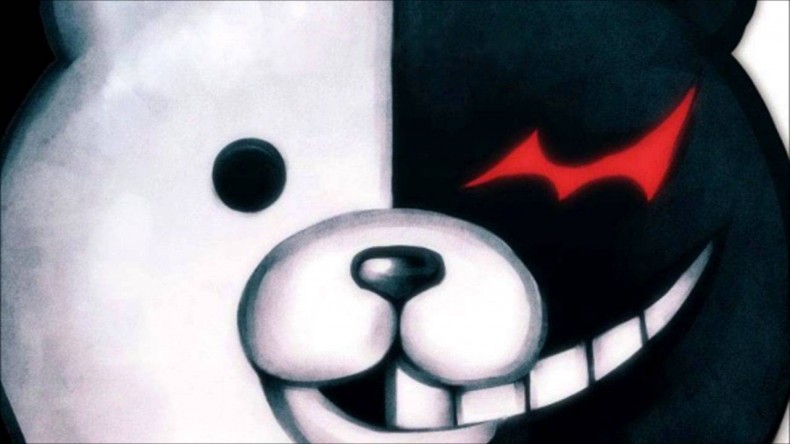Why, hello there! Thank you all for waiting! Now, let’s begin!
To be honest, I have no idea why it took me so long to give DANGANRONPA a fair shake. When you consider the premise and the art style it should have pushed all my buttons and had me eager to play. I never even knew it existed before it came out on Sony’s Vita. Maybe it was the fact it was a remake that put me off? Whatever the reason, I was a fool to leave it this long.
DANGANRONPA: Trigger Happy Havoc (or Academy of Hope and High School Students of Despair if you’re from the East) was released on the PSP in 2010. It then came to Japanese Android and iOS devices in 2012, before making it’s way to Japanese Vitas in 2013 and finally arriving in the West in 2014, in a sense I’m not that late to the party at all, but in another I’m turning up just as the DJ is winding down his set.
At the end of the day though, just what is DANGANRONPA? Well, it’s part visual novel, part rhythm action, part Ace Attorney, but all stylish. I have to get that in there as, for me, this is one of, if not the most stylish game I’ve ever played. This doesn’t come down to: ‘Oh, these sprites are cool.’ Or ‘The locations are well rendered.’ this is the whole package. The character designs are all totally unique and their personalities so well fleshed out, the UI perfectly crafted and easy to navigate, the soundtrack is amazing and the story is told in that irritatingly tease-stricken way that it frustrates you to the point that you want to get to the end to have your questions answered, but you also desperately want there to be more (sequels notwithstanding).
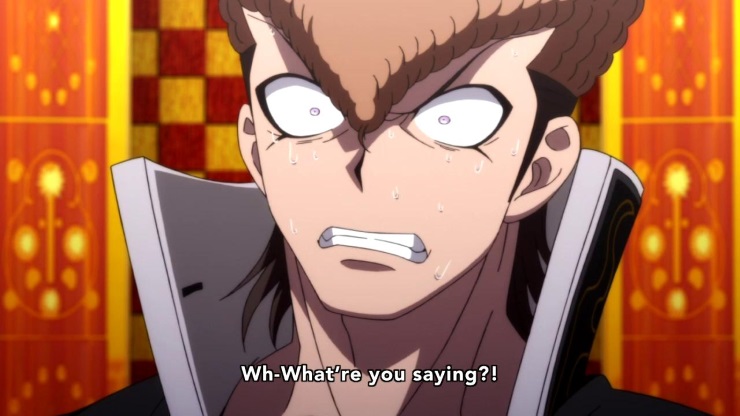
If it sounds confusing, it really is. Well, it is to outsiders at least. Once you’re in the game all the confusion and dissociative parts are indicative of the themes explored in the story. You can wind up just as confused as the characters are, as gameplay elements are layered on and new things introduced well into the fourth chapter. DANGANRONPA plays with your concepts of just what is going on from befuddling beginning to pulse pumping end.
The premise of the game is that you are Makoto Naegi, an ordinary student picked to join the country’s extra-ordinary elite at Hope’s Peak Academy. Things are not quite as they seem though. Once you and your fellow fourteen other students arrive things take a bizarre turn as you faint then awake to find the school dark and foreboding. The windows are bolted shut with steel plates and there’s a giant safe door where the entrance used to be. You know that escape isn’t going to be easy. The game’s bear mascot Monokuma confirms this minutes later when he beckons the student body to the gym for their entrance ceremony where he announces that all the students will be staying there forever with only one way out, to graduate. Graduation is only available to one person at Hope’s Peak and that is by way of murder. A student must murder one of their fellow classmates and get away with it, not a simple task by any means.
Makoto himself doesn’t partake in these murderous games, instead it falls to him to make friends with the other students and explore the school for clues as to how this predicament came about; at least that’s how it is between murders. Once the inevitable occurs you are tasked with seeking out evidence and gaining testimony from your fellow students to try and piece together how the grizzly event(s) came to pass. This is where DANGANRONPA most apes ‘Phoenix Wright’, as you move from location to location, tapping on areas of interest to progress the story. The game thankfully alleviates your frustration here by highlighting items of interest in your current area with a quick press of the button, further to this, a constantly available map of the school highlights rooms of interest with an exclamation mark but also allows fast travel from point to point making these sections feel less of a chore than the Ace Attorney games.
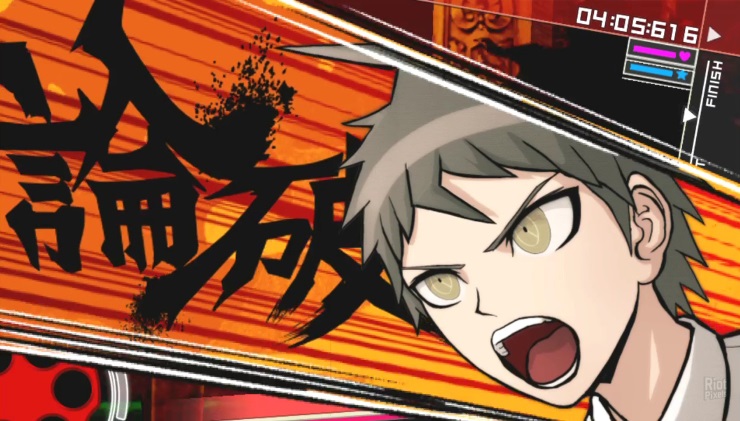
Thing is, you take the premise of the game, the main antagonist, the 2.5D motion graphics style, but nothing quite prepares you for the events that are the class trials. I said before in my Ace Attorney Trilogy review that when the ‘Cornered’ theme starts up and the Objection tennis begins it’s one of the most exciting things in gaming. Here in DANGANRONPA you’re in that mode for the entire event. The students stand in a circle and begin what is known as a NON-STOP DEBATE, here they bat ideas back and forth between them at a fair clip while a techno soundtrack assaults your eardrums. The frenetic nature of this back and forth discussion adds a sense of urgency to proceedings despite the extremely generous time-frames you are given.
The literal translation of DANGANRONPA is ‘Bullet Refutation’ and it’s in these trials is where it lives up to that. If you thought that the game wouldn’t attempt to be different any more, you’d be wrong. All the evidence and testimony you have gathered are loaded as TRUTH-BULLETS, and while the non-stop debate rages, orange text will be seemingly randomly placed amongst it. These flimsy statements are potentially weak to a truth-bullet. If you have evidence that contradicts what is said, then take aim and fire to destroy the argument. It sounds weird – well, it is – but it just works so well. You’re regularly already given the relevant bullet to fire at the start of each individual discussion, while later you’re either given multiple options for you to make the choice with, or you are able to copy some statements and use those as bullets against others. Trust me, it all makes sense when you’re actually in the middle of it all.
These trials can be punctuated with the occasional game of hangman or a brief rhythm action interlude. The former is more sedately paced than the debates and has you shooting letters to create the word for an item of evidence. The latter, however, is a Mano-a-Mano battle between you and another student. You’re attacked with a barrage of insults by your opponent and you need to tap X in time with the beat to take aim at their statements and then shoot them down. As the battle goes on the tempo increases or decreases in an attempt to catch you out. Your opponent even obstructs the icon bar at times so you can’t see the beat markers, making you have to rely on the music itself.
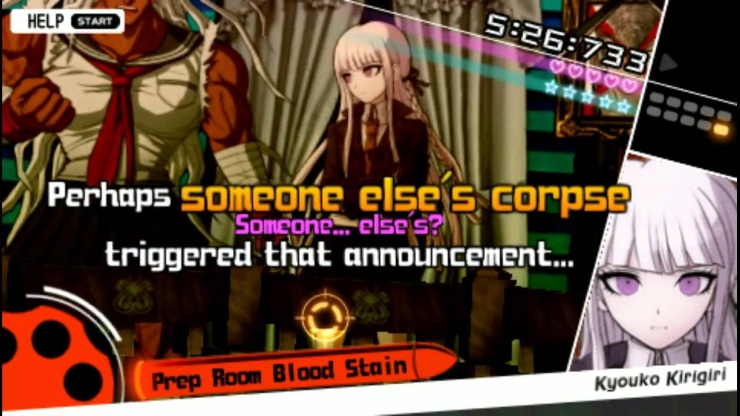
When the guilty party is worn down you’re asked to put together the closing argument. What you’re given is a comic strip with missing panels. This storyboards the events leading up to and shortly after the murder. It’s your duty to fill in the gaps with suggested elements below the strip and then to watch it play out. Any mistakes bring you back to the strip to remove and correct the offending section. It’s against the clock, but they’ve been generous giving you ample time to think carefully and logically for each selection.
That’s the thing here, considering the nature of the game; it is quite lenient. There’s no real fail state to speak of for any segment. If you make too many wrong choices over the course of the trial you’re just asked to try again, this makes it even more forgiving that the Ace Attorney games which would dump you back at your last save point. Something like that would ruin DANGANRONPA’s flow entirely and that would be a crime as once you’re swept up in its wave you just want to ride it for as long as is possible.
When all is said and done, the guilty party has been uncovered and the trial is over, you’re treated to Monokuma’s ‘Punishment time’ where your black and white antagonist commits a brutal execution of the killer. It should come as no surprise that these are completely outlandish and sadistic, but they’re also morbidly entertaining. It is a little bit disturbing when you realise that one aspect driving you forward is finding out just what form the next execution will take.
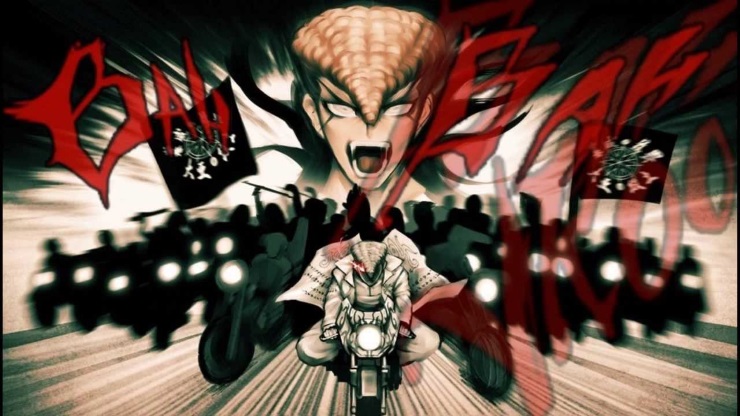
As the game goes on this structure doesn’t change: school life continues, a murder occurs, you investigate and a trial is held – but it never grows stale. This is helped by a story that is fed in dribs and drabs, teasing you constantly to see the next revelation, the next twist, the next deception. You can’t affect the outcome aside from progressing the story, so you’re only along for the ride, but it’s a damn good one. The excellent characterisation helps this greatly and you can’t help but feel upset as some of the genuinely likable characters are killed off as the game progresses. One character in particular is handled thoughtfully despite the lack of presence for the demographic in gaming. There are some issues, but it is a step in a positive direction.
Rui Komatsuzaki’s character designs are excellent, with just the right level of detail for each one to be different while still not being over-designed (you know, like some JRPG characters can tend to be), the 2.5D motion graphic cut-scenes do a brilliant job of showing these off in some beautiful and brutal ways. Hope’s Peak Academy’s dark halls convey the oppressive nature of the school and the regime it has fallen into excellently. There’s a constant unease as you move throughout its corridors regardless of what background music that is playing at that moment.

Which brings us onto how good DANGANRONPA sounds. From rip roaring intro to heart thumping trial by way of jovial free time and horrifying unease, the perfect music accompanies every situation. There’s a guaranteed favourite tune for everyone here, and I challenge you to not tap your feet to the game’s main theme. There’s the choice of Japanese or English voice acting depending on your preference. You can’t lose regardless of choice as the translation has been handled extremely well. The voice actors suit their characters to a T, with some stellar performances put forward.
As a whole package DANGANRONPA is almost without fault. Terrific writing, excellent looks, fantastic sound, stylish, functional UI, great characterisation and a top notch story which makes every cliché it embraces work within itself. As a visual novel it shouldn’t be surprising that the ending adopts a style akin to manga. It gives you a resolution, but makes you fill in blanks by yourself. This leaves behind a sense of frustration that several questions that were teased throughout are left unanswered. But the game itself is the event, every twist and turn is superbly delivered. It leaves you guessing through each case, right up until the game’s climax and beyond.

There’ll be many people who won’t give DANGANRONPA the time of day due to its visual novel style, its Japanese leanings or even Monokuma’s presence on the boxart – but those people would be missing out. Missing out on a terrific narrative experience that subverts a lot of established tropes in regards to characterisation and adds a unique gameplay experience that just completely takes you by surprise. Going into too much detail runs the risk of spoiling what makes DANGANRONPA truly special, and that makes it such a hard game to write about. It’s got a great story that carries you through it at a cracking pace and one of the best antagonists I’ve encountered in all my years of playing games, the reveal of whom is delivered brilliantly.
I implore you to give Danganronpa a chance, it invites you into its twisted world with a disturbing smile and holds you tight in a cuddly yet uneasy embrace – so warm and wet, so wet and warm – before assaulting you with a glorious feast for your eyes and ears. It’s managed to work its way into my top games of all time, amongst lofty company like Metal Gear Solid 3, ICO and Legend of Zelda: A Link to the Past. That doesn’t happen regularly.
This is a game that bombards you with images of despair, absurdity and violence, yet urges you to have fun and gives you earworm for days. I’ve stated before that the game gives you time, plenty of it, but none of it is Punishment time.


